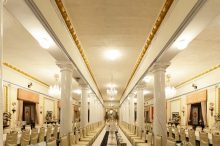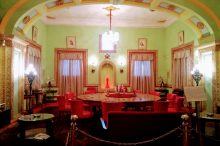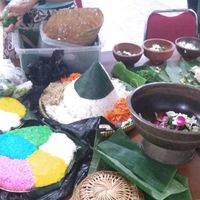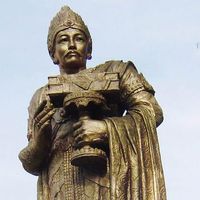HH Maharaja Sir Jiwajirao Scindia Museum, India

 The Jai Vilas Palace was commissioned as a private residence by HH Maharaja Shrimant Jayajirao Scindia in 1875 to commemorate the visit of King Edward VII.
On 12 December, 1964 the west wing of the magnificent Jai Vilas Palace was converted into a museum by the late Rajmata Vijaya Raje Scindia in the memory of her beloved husband HH Maharaja Sir George Jiwajirao Scindia. The HH Maharaja Sir Jiwajirao Scindia Museum, a living Palace Museum, was inaugurated by Dr. Sarvapalli Radhakishnan, the then president of India. The Museum is managed and administered under Mannu Raje Charitable Trust.
In 2002, Shrimant Priyadarshini Raje Scindia took the active control of the Museum and commenced the journey towards a multidimensional museum, with all its possible attributes.
The mega structure of the Palace is built in 12,40,771 square feet area, and it is the finest illustration of European architecture, designed and built by Lt. Colonel Sir Michael Filose. The Palace architecture is a combination of Tuscan and Corinthian style, with strong Baroque influences.
The recently renovated museum offers a unique experience of a charismatic blend of art and history from the Scindia collections. The Museum, with its unique architecture, interiors and rare artifacts, is one of its kinds in the country.
Since October 2018, visitors can discover the newly-opened State room. State rooms, which became popular in the late 17th and early 18th centuries, mostly in European countries and possibly in large princely states in India, as in the Gwalior state under Scindia before independence, were primarily an official room where kings would have meetings with selected officials to resolve issues in their regions. As kings would preside over such meetings, these rooms had special significance and importance.
The Jai Vilas Palace was commissioned as a private residence by HH Maharaja Shrimant Jayajirao Scindia in 1875 to commemorate the visit of King Edward VII.
On 12 December, 1964 the west wing of the magnificent Jai Vilas Palace was converted into a museum by the late Rajmata Vijaya Raje Scindia in the memory of her beloved husband HH Maharaja Sir George Jiwajirao Scindia. The HH Maharaja Sir Jiwajirao Scindia Museum, a living Palace Museum, was inaugurated by Dr. Sarvapalli Radhakishnan, the then president of India. The Museum is managed and administered under Mannu Raje Charitable Trust.
In 2002, Shrimant Priyadarshini Raje Scindia took the active control of the Museum and commenced the journey towards a multidimensional museum, with all its possible attributes.
The mega structure of the Palace is built in 12,40,771 square feet area, and it is the finest illustration of European architecture, designed and built by Lt. Colonel Sir Michael Filose. The Palace architecture is a combination of Tuscan and Corinthian style, with strong Baroque influences.
The recently renovated museum offers a unique experience of a charismatic blend of art and history from the Scindia collections. The Museum, with its unique architecture, interiors and rare artifacts, is one of its kinds in the country.
Since October 2018, visitors can discover the newly-opened State room. State rooms, which became popular in the late 17th and early 18th centuries, mostly in European countries and possibly in large princely states in India, as in the Gwalior state under Scindia before independence, were primarily an official room where kings would have meetings with selected officials to resolve issues in their regions. As kings would preside over such meetings, these rooms had special significance and importance.  This State room of the Scindias was established during the period of Maharaja Madhavrao Scindia I (1886-1925) and continued until the reign of Maharaja Jiwajirao Scindia, when India became independent. The room has been lavishly decorated with a floral border all around the walls of the room.
In May 2019, the original royal kitchen of the palace was also reopened. The royal kitchen was first established during the time of Maharaja Madhav Rao Scindia I in the east wing of the Jai Vilas Palace. He was in love with French Culture and cuisine and hence established this kitchen to serve French food and delicacies. The royal kitchen has the echo and whisper of three cultures i.e. Indian, French, and English.
This State room of the Scindias was established during the period of Maharaja Madhavrao Scindia I (1886-1925) and continued until the reign of Maharaja Jiwajirao Scindia, when India became independent. The room has been lavishly decorated with a floral border all around the walls of the room.
In May 2019, the original royal kitchen of the palace was also reopened. The royal kitchen was first established during the time of Maharaja Madhav Rao Scindia I in the east wing of the Jai Vilas Palace. He was in love with French Culture and cuisine and hence established this kitchen to serve French food and delicacies. The royal kitchen has the echo and whisper of three cultures i.e. Indian, French, and English.
 The Kitchen is divided into six parts, namely cooking area, preparation area, Butler's pantry, Sculler, Larder and Refrigerator, among which the refrigerator is not open for the public but is functional. Two main kitchen apparatuses have been installed in the cooking area; one is Briffault Open range (oven) on the right side of the door, and other is Briffault closed range (oven) on the left side of the main door. In the metamorphose, more efficaciously, Indian elements were added to it during the time of Maharaja Madhavrao Scindia II.
The Kitchen is divided into six parts, namely cooking area, preparation area, Butler's pantry, Sculler, Larder and Refrigerator, among which the refrigerator is not open for the public but is functional. Two main kitchen apparatuses have been installed in the cooking area; one is Briffault Open range (oven) on the right side of the door, and other is Briffault closed range (oven) on the left side of the main door. In the metamorphose, more efficaciously, Indian elements were added to it during the time of Maharaja Madhavrao Scindia II.
Permanent collections:
Furniture: The Museum has a large collection of diverse furniture; namely, French, English, Malabar, Oriental and crystal. These were also made in India in the past patronized by the Scindias. The Scindias were fond of travelling, and during their visits to Western countries they collected a variety of furniture and artifacts for their personal use and for the Jai Vilas palace, some of which can be seen in the museum. Carriage: There is a saying that ‘royalty is well defined through carriages’. The size, design and material used in making of the carriages were largely dependent on their usage and purpose. Silver buggy, silver chariot, royal palanquins, open palanquins, gifted carriages, hunting haudahs and modern vehicles are some of the main collections that are displayed in the museum. Paintings: Raja Man Singh Tomar was a great patron of art, therefore during his reign a school of miniature paintings had flourished in Gwalior. In the miniature segment, the museum has artifacts of the aforesaid school and also Maratha style paintings made in Gwalior. In Western art, valuable oil paintings, tondos and 3-D paintings were also collected by the royal family from time to time. Prints: Lithographs of Napoleon and Tipu Sultan are some of the rarest collections of the Scindias that are displayed in the museum. In addition, valuable patent-coloured prints of Western art works, collected by the royal family, make their collection rich. Some of these are displayed in the museum. Sculptures: Sculptures from the 2nd Century BCE to the 20th Century CE are kept in the museum. Sandstone sculptures were acquired from the Gwalior Fort which belonged to the Tomars. Apart from this, marble sculptures from the West and patent replicas of the masterpieces collected by the royal family make the collection multifaceted. Decorative art: The museum has a vast collection of decorative arts from the 19th to 21st Century. It includes ivory, metal, glass, crystal, ceramic, wood and stone. Silver and ivory are considered pious, and hence these were used for photo frames. In addition ceramic decorative plates, crystal and silver crockery, make the collection rich and unique. Textile: The chanderi fabric has always been exclusive among the different textiles of India because of its sheer texture and light weight. It was preferred by the Mughals, and in early 20th Century CE the chanderi fabric was patronised by the royal family of Gwalior. Since then it has become the royal fabric of Scindias. In the Museum one can see the authentic chanderi saree of cotton with gold border. Arms and Armour: Museum has a vast collection of arms and armour used by the Scindia in the past and in World War I and II. It includes a variety of swords, spears, daggers, guns, pistols etc.View all Asia-Europe Museum Network (ASEMUS) members in India
Similar content
posted on
29 Feb 2012
posted on
03 Feb 2012
posted on
01 Feb 2012
posted on
06 Sep 2010
17 Oct 2015 - 17 Jan 2016


